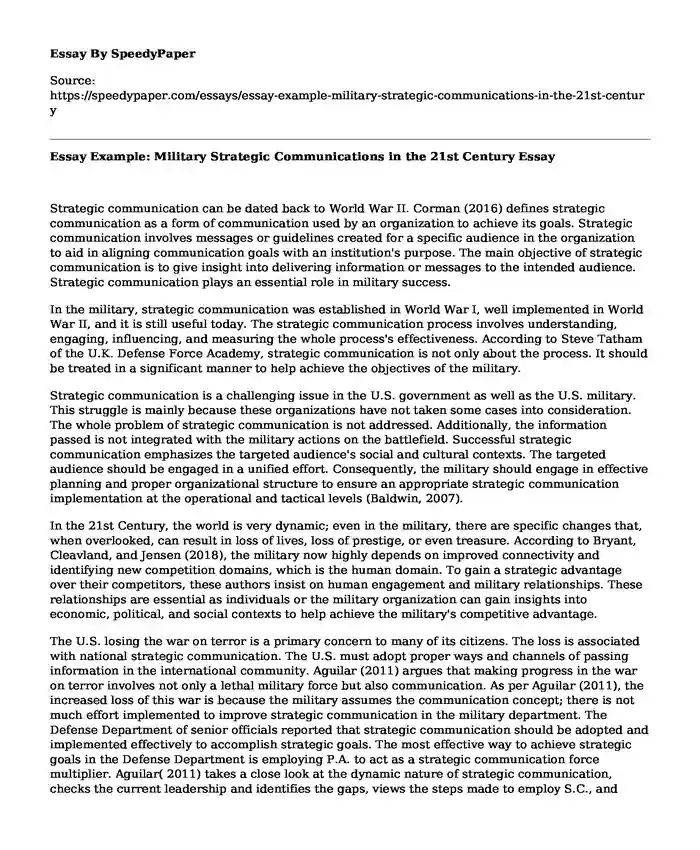
| Type of paper: | Essay |
| Categories: | Strategy Communication United States War |
| Pages: | 3 |
| Wordcount: | 676 words |
Strategic communication can be dated back to World War II. Corman (2016) defines strategic communication as a form of communication used by an organization to achieve its goals. Strategic communication involves messages or guidelines created for a specific audience in the organization to aid in aligning communication goals with an institution's purpose. The main objective of strategic communication is to give insight into delivering information or messages to the intended audience. Strategic communication plays an essential role in military success.
In the military, strategic communication was established in World War I, well implemented in World War II, and it is still useful today. The strategic communication process involves understanding, engaging, influencing, and measuring the whole process's effectiveness. According to Steve Tatham of the U.K. Defense Force Academy, strategic communication is not only about the process. It should be treated in a significant manner to help achieve the objectives of the military.
Strategic communication is a challenging issue in the U.S. government as well as the U.S. military. This struggle is mainly because these organizations have not taken some cases into consideration. The whole problem of strategic communication is not addressed. Additionally, the information passed is not integrated with the military actions on the battlefield. Successful strategic communication emphasizes the targeted audience's social and cultural contexts. The targeted audience should be engaged in a unified effort. Consequently, the military should engage in effective planning and proper organizational structure to ensure an appropriate strategic communication implementation at the operational and tactical levels (Baldwin, 2007).
In the 21st Century, the world is very dynamic; even in the military, there are specific changes that, when overlooked, can result in loss of lives, loss of prestige, or even treasure. According to Bryant, Cleavland, and Jensen (2018), the military now highly depends on improved connectivity and identifying new competition domains, which is the human domain. To gain a strategic advantage over their competitors, these authors insist on human engagement and military relationships. These relationships are essential as individuals or the military organization can gain insights into economic, political, and social contexts to help achieve the military's competitive advantage.
The U.S. losing the war on terror is a primary concern to many of its citizens. The loss is associated with national strategic communication. The U.S. must adopt proper ways and channels of passing information in the international community. Aguilar (2011) argues that making progress in the war on terror involves not only a lethal military force but also communication. As per Aguilar (2011), the increased loss of this war is because the military assumes the communication concept; there is not much effort implemented to improve strategic communication in the military department. The Defense Department of senior officials reported that strategic communication should be adopted and implemented effectively to accomplish strategic goals. The most effective way to achieve strategic goals in the Defense Department is employing P.A. to act as a strategic communication force multiplier. Aguilar( 2011) takes a close look at the dynamic nature of strategic communication, checks the current leadership and identifies the gaps, views the steps made to employ S.C., and analyzes leveraging P.A. as the Strategic communication facilitator in the military.
Conclusion
In conclusion, the military is a sensitive organization. The success of the military should be one of the topmost priorities of a state. However, this success does not involve military action and lethal weapons only. This paper illustrates how strategic communication is crucial in the military. The adoption of strategic communication gives the military a relative advantage. The involved authorities should consider the targeted audience's culture and social contexts. Successful implementation of S.C. also depends on the relationship and connectivity in the institution.
References
Aguilar, Kirsten. (2011). Public Affairs: A Strategic Communication Force Multiplier. 25.
Baldwin, R. (2007). A New Military Strategic Communications System. Apps.dtic.mil.
Bryant, S., Cleavland, C., & Jensen, B. (2018). Military Strategy in the 21st Century: People Challenges for Policymakers. State, Society and National Security, 171–182.Connectivity and Competition. Cambria Press. https://apps.dtic.mil/dtic/tr/fulltext/u2/a470460.pdf.
Corman, S. R. (2016). The 21st Century Strategic Communication Landscape and its https://doi.org/10.1142/9789813140127_0011
Cite this page
Essay Example: Military Strategic Communications in the 21st Century. (2023, Dec 14). Retrieved from https://speedypaper.com/essays/essay-example-military-strategic-communications-in-the-21st-century
Request Removal
If you are the original author of this essay and no longer wish to have it published on the SpeedyPaper website, please click below to request its removal:
- Essay Example on Strategic Management Accounting
- Essay Sample on the Reasons for the High Cost of Driving a New Car in the United States
- Essay Sample on Reduce and Refuse Plastic Wastes in the United States
- Free Essay: Culture Effects on Global Business
- Essay Sample on The Settlement of the Middle Atlantic Lands
- Free Paper Sample on Constitutional Issue: Feedom of Speech
- Interagency Collaboration and Homeland Security - Free Paper Sample
Popular categories




